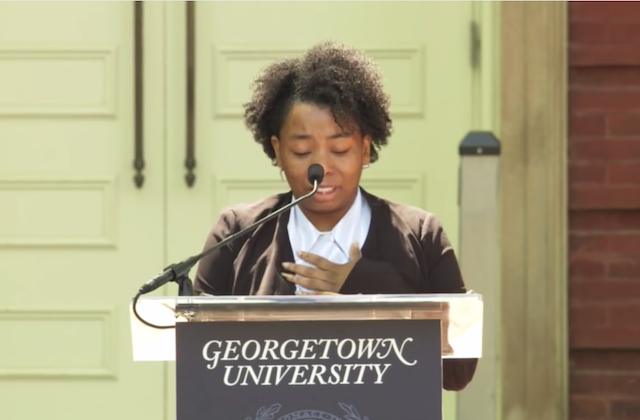A year-and-a-half after students staged a sit-in to demand that Georgetown University rename buildings that bared the monikers of past university presidents who sold enslaved Black people to settle school debt, university officials honored that request.
Yesterday (April 18), the university held a ceremony to apologize for its role in the slave trade. Per a statement released by the university, more than 100 descendants of the 272 enslaved Black people who were sold in 1838 attended the Liturgy of Remembrance, Contrition and Hope. Several of them appear in the video above, talking about their ancestral ties to the university.
“Today the Society of Jesus, who helped to establish Georgetown University and whose leaders enslaved and mercilessly sold your ancestors, stands before you to say that we have greatly sinned,” Rev. Timothy Kesicki, S.J., president of the Jesuit Conference of Canada and the United States, said at the program. “We pray with you today because we have greatly sinned and because we are profoundly sorry.”
Officials also permanently renamed two buildings. The former Mulledy Hall (which was temporarily renamed Freedom Hall in late 2015 following the protest) is now called Isaac Hawkins Hall. Thomas F. Mulledy is the past university president who authorized the sale of the 272 enslaved people to a Louisiana plantation. Hawkins was the first enslaved person listed on the papers documenting the 1838 sale.
And the former McSherry Hall—named for past president William McSherry, who was also involved in that sale—was changed from the temporary Remembrance Hall to Anne Marie Becraft Hall. At the age of 15, Becraft—a free Black teenager—opened a school in Georgetown to educate Black girls in 1820. She went on to become one of the nation’s first Black nuns.
“The actions of Georgetown students have placed all of us on a journey together toward honoring our enslaved ancestors by working toward healing and reconciliation,” Karran Harper Royal, one of the descendants, said at the program. “Our history has shown us that the vestiges of slavery are a continuum that began with the kidnapping of our people from our motherland to keeping them in bondage with the brutality of American chattel slavery, Jim Crow, segregation … the school to prison pipeline and the over-incarceration of people of color.”
The university also hosted a dinner and private vigil for the descendants and took them on a tour of the plantation where their ancestors lived before the sale. Last September, officials announced several measures meant to reconcile for its history, including extending admissions preference for the descendants of the people the school once owned.
Watch the ceremony below:
And the building dedication here:
